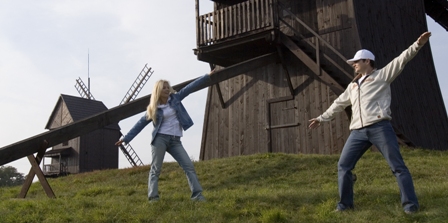Beauty hidden in wood

This trail will lead you to historical wooden buildings. Until 300 years ago wood was the basic building material. Few wooden historical structures have remained being evidence of the glorious past. It is interesting to look at them from up close. The trail consists of ten historical buildings of various significance. The most interesting ones have been marked with an asterisk *
- We leave Leszno in the northern direction following road no.5 to Śmigiel.
- * Śmigiel – St. Wit’s Chapel – a chapel with a framework structure filled with stones and bricks built in 1769. We can admire the main altar, which is a late Gothic sculptured triptych dating from 1506 in a frame dating from 1645. The middle part presents the Assumption and the other parts present the Visitation, the Three Magi, the Annunciation and the Birth of Jesus Christ.
- We leave Śmigiel following the road to Przemęt, then to Gołanice and to Bronikowo.
- * Bronikowo – St. Francis of Assisi Parish Church – a temple of a framework structure built in 1739 from larch wood. Inside there are baroque altars and paintings dating from the late 17th century.
- Then we go to Gołanice. Here we follow the road to Włoszakowice and after passing Jezierzyce Kościelne we turn left to Zbarzewo and Niechłód.
- Niechłód – All Saints Chapel – a framework wooden structure. Inside we can admire a virtual barrel vault. Furnishings include: paintings and baroque crucifixes.
- We return to Leszno following road no. 5 in the direction of Wrocław and we drive to Rydzyna.
- * Rydzyna – “Józef” windmill – now it is the Museum of Agriculture and Milling. The windmill site is a place where interesting festivals and events are organized. In the past there were about thirty such structures in the area.
- We follow road no.5 in the diection of Wrocław and we drive to Kaczkowo.
- Kaczkowo – St. Martin’s Parish Church. It was built in 1674 with the help of the Lessem-Stoschów family as a wooden structure. In 1817 the wood was replaced with a framework structure filled with bricks. During World War II it was the only Catholic church open to Poles within thirty kilometres.
- We continue the tour following road no. 5. After passing Bojanowo we turn left in the direction of Miejska Górka to Zakrzewo.
- * Zakrzewo – St. Clement’s Parish Church – a wooden temple with a framework structure. It was built in 1610. In 1647 an extension was added – Consolation of the Blessed Mary chapel and sacristry made of brick. The most beautiful element of the church in Zakrzewo is baroque polychromy covering the whole of the interior dating from 1730. On the walls, the vault and columns there are figurals, scenes from the life of Mary Mother of God as well as various ornaments.
- We return to Kawcze where we turn right in the direction of Poniec.
- * Poniec – an arcade building no. 31 in the Market Square. It is a rare example of a preserved house in town of a framework structure filled with bricks. The arcade is supported with four posts with braces.
- In Poniec we follow the road to Gostyń and then to Krzemieniewo, Oporówko and finally Oporowo.
- * Oporowo – Immaculate Conception of the Virgin Mary Parish Church. It is a framework structure temple built in 1640 thanks to the foundation of Stanisław Śmigielski. It was renovated in 1870. We can admire opulent baroque interiors consisting of altars and a hanging candlestick decorated with the sculpture of the Blessed Virgin Mary Immaculately Conceived standing on a dragon.
- We leave Oporówko and drive straight on to Lubonia, Pawłowice and Osieczna.
- Osieczna – windmills – on a hill on the way from Leszno there are three historical windmills. The oldest one standing in the centre dates from 1763. The others were built in the 19th century.
- We follow road no. 432 to Leszno.
Autor artykułu:
Opublikował: Konrad Andrzejewski kontakt: kandrzejewski@leszno.pl ostatnia zmiana:




